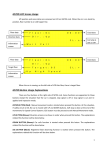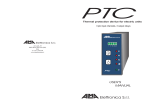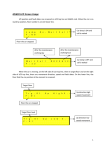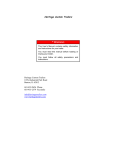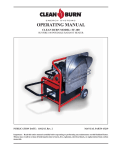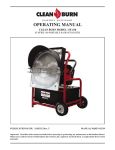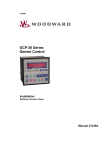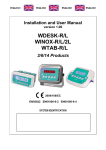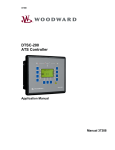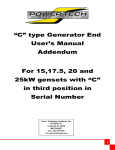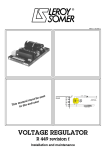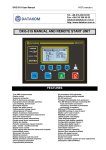Download AMF 4.0 AUTOMATIC MAINS FAILURE UNIT USER MANUAL V1.35
Transcript
AMF 4.0 AUTOMATIC MAINS FAILURE UNIT USER MANUAL V1.35 (AMF 4.0 version 20) AMF 4.0 Automatic Mains Failure IR G Oil press IS Temp Esc A START I/0 I/0 IT STOP Battery TEST OFF VR VRS VS VS T VT VT R MENU 50 122 0 0 C F MAINS GEN AUX. V Engine hour Freq 100 212 0 0 C F TEMPERATURE LEVEL Critical Level OIL LEVEL Max. Level DESCRIPTION AMF 4.0 genset control unit provides the functions, required in automatic mains failure applications of gensets. It can be operated in automatic, test and manual modes. It contains digital displays providing functions of all analog displays needed in generator panels. Device digital displays show 3 phase mains and generator voltages, 3 phase generator currents, mains and generator frequencies, battery voltage, oil pressure (bar), engine temperature and engine hour. Generator is monitored constantly and when generator or mains values exceed the limits adjusted in the parameter menu, necessary actions are taken and alarm is activated. Last ten alarm is recorded in the device memory. All operating modes and timings can be adjusted in the parameter menu. This flexibility is provided for different kinds of generator applications. FUNCTIONS • Manual engine starting and stopping • Mains monitoring, automatic start, stop and transfer switch functions • True RMS voltage and current measurements • Failures monitoring • Preheating • Manuel, automatic and test modes • Cost effective digital measurement displays • Recording of last 10 failure • Engine hour measurement and periodic service time warning • Manuel and automatic control of mains and generator contactors • Analog engine temperature and oil pressure measurement capability • Adjustable operating modes and timings via parameter menu • Analog bar graph, engine temperature and oil pressure displays • Adjustable measurement calibrations • Remote Start 1 INPUT / OUTPUTS 3 phase mains and generator voltage inputs 3 phase generator current inputs 12 or 24 V battery supply input Oil pressure and temperature analog inputs Charge alternator input Cranking relay output Preheat relay output Fuel solenoid relay output Mains contactor relay output Generator contactor relay output Alarm relay output 2 programmable auxiliary relay output 2 programmable auxiliary input Engine start/stop failure Under/over speed failure Under/over voltage failure Over current failure High temperature failure Charge fail warning Low oil pressure failure Periodic service time warning Auxiliary failure • • • • • • • • • AMF 4.0 CONNECTION DIAGRAM LOAD MAINS R R S T GENERATOR U N S V T W N N 12 22 23 24 25 14 26 27 28 29 13 30 31 16 17 18 19 Configurable Input 4 21 Configurable Input 3 20 Temperature Sender 10 Configurable Input 2 (Default Temperature Switch) Charge 9 Oil Pressure sender Com 2 Fuel Selenoid Preheating Ralay Crank Relay Crank 8 7 Configurable output 3 15 6 4 Configurable output 2 5 Configurable output 1 (Default Horn) 3 32 33 34 35 AMF 4.0 Emergency Stop Power Supply Mains Contactor Relay 2 1 G Generator Current Inputs Generator Contactor Relay Configurable Input 1 (Default Oil Pressure Switch) 11 Battery • • • • • • • • • • • • • ALARMS D+WL NEGATIVE TERMINAL OF BATTERY SHOULD BE GROUNDED 2 FRONT PANEL 1 AMF 4.0 5 Automatic Mains Failure 4 IR G 9 Oil press IS Temp Esc A START I/0 I/0 IT STOP Battery TEST OFF VR VRS VS VS T VT VT R 2 3 6 MENU AUX. V Engine hour Freq 7 50 122 0 C 0 F MAINS 100 212 0 C 0 F TEMPERATURE LEVEL GEN Critical Level OIL LEVEL Max. Level 8 PreHeat Button(1): When genset doesn’t start in cold weathers, engine can be preheated with this button. Button function can be set as “button must be held down to preheat” or “preset preheat time when you press button”. Preheat button can be used in manual mode and when engine is not running. Start Button: This button is used to start genset . Panel will stop cranking when it detects engine running signals. Button function can be set as “button must be held down to crank” or “preset cranking time when you press button”. Start button can be used in manual mode and when engine is not running. Panel will display “Str” message during cranking. Stop Button: This button is used to stop the genset. When you pressed this button first time panel switched to manual mode and if generator contactor is used before, genset is switched to cooling mode. If you pressed second time genset stops immediately. Second function of this button when you press more than 3 seconds panel will switch to off mode. Generator Contactor (2): This button is used to transfer load to genset. When genset is running this button can be used. Led lamp above the button shows contactor status. When the led lamp is lit, contactor is closed. Generator contactor cannot be closed when the mains contactor is closed. To close generator contactor, you must open the mains contactor first. In engine running condition, when you press stop button, generator contactor will open immediately. 3 Mains Contactor (3): This button is used to control mains contactor. It cannot be closed if generator contactor is closed. Generator Status Led Lamp (4): • It is off, if engine isn’t running. • It is on, if engine is running • It is blinking, if genset is in engine stabilization, cooling or stopping. These topics will be explained later Mains Status Led Lamp (5): • It is off, if mains voltage is outside the limits of preset values. • It is on, if mains voltage is inside the limits of preset values. • It is blinking in transition times (mains failure delay and mains return delay) if mains change the state from normal to failure or failure to normal state Alarm Led Lamps (6): From the upper left corner, high and low generator speed, high and low generator voltage, high coolant temperature, over current and service alarms. From lower left corner start and stop failure, low oil pressure, charge failure, battery voltage failure and auxiliary alarms. Detailed description will be given in the following chapters. Oil Pressure and Coolant Temperature bar graphs (7): Analog oil pressure and coolant temperatures can be seen in bar graphs. In temperature bar graph temperature can be seen from 50° C/ 112 °F to 100 °C/212 °F. In oil press bar graph, oil press can be seen from oil pressure failure level to maximum oil press sender level. Display Leds: These leds are in the right side of numerical displays. Leds indicates meaning of the value in the displays. Values in the displays can be changed by up, down and menu buttons. Measuring Mode Button (8): The button selects the displayed values at lower 2 numerical display. These displays can show generator voltage and frequency or mains voltage and frequency. Esc Button: This button has multiple tasks. These are listed below, • In alarm condition, first press stops the horn and second press clears the alarm. • It is used to exit parameter menu. For this process button must be held down 3 seconds. • In the process of changing parameter when you enter invalid values you can cancel by this button. Menu Button (Enter): This button has multiple tasks. These are listed below • It is used to select the values in the numerical displays. When you press first time led will be lit on the right of the display that is in selection mode. If you press up and down buttons before stop blinking you can change the value shown in display. If the display that is wanted to change mode is different you can press menu button and change the display in selection mode. • If you press this button 3 seconds, you will enter the parameter menu. In parameter menu you can use menu button to change selected parameter. You can change the active digit. After all active digits are set last press will write value to parameter memory. Detailed information will be given in parameters section. 4 Up, Down Buttons (+, -): This button has two tasks. These are listed below. • It is used to select the values in the numerical displays. When you press first time led will be lit on the right of the display that is in selection mode. If you press second time you can change the value of display that is in selection mode. • In parameter menu you can press menu button to change selected parameter. You can change the number of active digit. Running Mode Buttons (9): These are manual (hand mark) , automatic (A letter) and test buttons. These buttons set running mode of genset. There is mode indication leds near each of these buttons. When panel is in off mode you can press these buttons to wake up panel and genset will run in selected mode. PREHEAT CRANKING FUEL SELENOID COM 2 AUX. OUTPUT 1 AUX. OUTPUT 2 MAINS CONT. COM. TEMPERATURE BATT (-) COM 1 OIL PRESSURE 11 12 13 14 15 16 17 18 19 20 21 AUX. INPUT 3 9 10 AUX. INPUT 4 8 AUX. INPUT 2 7 AUX. INPUT 1 6 CHARGE FAIL-EXCIT. 5 GEN. CONT. NO 4 MAINS CONT. NC 3 GEN CONT. COM. 2 AUX. OUTPUT 3 1 BATT (+) REAR CONNECTIONS CURRENT TRANSFORMER INPUTS R S T N U V W N IR IR IS IS IT IT - + - + - + G 22 23 24 25 26 27 28 29 30 31 32 33 34 35 5 CONNECTIONS Terminal No Terminal Name Bat (+) 1 Bat (-) 2 3 Com 1 4 5 6 Preheat Cranking Fuel Solenoid 7 8,9,10 Com 2 Aux. Output 1,2,3 11 HIGH VOLTAGE 12 HIGH VOLTAGE 13 HIGH VOLTAGE 14 HIGH VOLTAGE 15 Mains Cont. Com. Description Battery positive. Voltage must be between 9- 30 V Battery negative. Battery negative must be connected to earth. Common terminal of preheat, fuel solenoid and cranking relays. Preheat relay Cranking relay Fuel or stop solenoid relay. Operating mode must be selected from parameter menu. Common terminal of auxiliary relay 1,2,3 Multiple function auxiliary relay outputs. Auxiliary output 1 is default horn output. Input terminal of mains contactor relay. Line R of mains can be connected to this terminal Mains Cont. NC Output terminal of mains contactor relay. This output is connected to mains contactor. Gen Cont. Com. Input terminal of generator contactor relay. Line U of generator can be connected to this terminal Gen Cont. NO Output terminal of generator contactor relay. This output is connected to generator contactor. Charge Fail Excit. Warning lamp output of charge alternator must be connected here. In the cranking excitation current is supplied to charge alternator over 150 ohm resistor. Multiple function auxiliary input. These inputs are activated if it is connected to battery negative. If oil sender that have both sender and switch function is used, switch terminal must be connected to this terminal. Suitable configuration must be set for this input to use it as oil pressure switch input. If this input is used for auxiliary input. Alarm will be shown as A1 in the display at the same time with auxiliary led indication. Multiple function auxiliary input. These inputs are activated if it is connected to battery negative. If temperature sender that have both sender and switch function is used, switch terminal must be connected to this terminal. Suitable configuration must be set for this input to use it as temperature switch input. If this input is used for auxiliary input. Alarm will be shown as A2 in the display at the same time with auxiliary led indication. 16 Aux. Input 1 17 Aux. Input 2 6 18 Aux. Input 3 19 Aux. Input 4 20 Oil Pressure 21 Temperature 22,23,24,25 HIGH VOLTAGE 26,27,28,29 HIGH VOLTAGE 30,31,32,33 34,35 Mains Line Neutral Inputs Multiple function auxiliary input. These inputs are activated if it is connected to battery negative. If this input is used for auxiliary input. Alarm will be shown as A3 in the display at the same time with auxiliary led indication. Multiple function auxiliary input. These inputs are activated if it is connected to battery negative. If this input is used for auxiliary input. Alarm will be shown as A4 in the display at the same time with auxiliary led indication. If oil sender that have both sender and switch function is used, sender terminal must be connected to this terminal. If oil sender that has single oil pressure switch output, switch output must be connected to this input. Suitable configuration must be set for this input to use it as oil pressure switch or sender input. If temperature sender that have both sender and switch function is used, sender terminal must be connected to this terminal. If temperature sender that has single temperature switch output, switch output must be connected to this input. Suitable configuration must be set for this input to use it as temperature switch or sender input. and Mains line and neutral are connected to these terminals. Generator Line and Generator line and neutral are connected to these Neutral Inputs terminals. Curent Inputs Transformer Secondary side of current transformer must be connected here. Each transformer must be connected separately. Note: Battery negative must be connected to earth RUNNING MODES Automatic Mode: If you press automatic button marked “A” genset will switch to automatic mode. In this mode panel controls mains voltages and if mains is outside the limits that you programmed, Panel will open the mains contactor and starts the genset. After “engine stabilization time” and “generator contactor delay” load transferred to the generator. Panel controls all the engine values to detect possible failures after engine stabilization time. If mains come to normal condition, mains is controlled during “mains return delay” for stabilization. If mains is normal “after mains return delay”, generator contactor opens and mains contactor closes. Genset is stopped after cooling period. In automatic mode, if panel is in engine off state and detects an engine running signal. Panel will stop the engine. Test Mode: If you press test button at the right side of front panel. Genset will be switched to test mode. In test mode engine starts immediately. After “engine stabilization time” if parameter ”test mode” is test off load genset wait for mains failure in running condition. When mains failure occur mains contactor opens and generator contactor closes. In same way when mains returns, panel waits ”mains return delay” and switch back to mains. If parameter “test mode” is test on load. After engine starting, generator contactor closes and genset supply 7 the load. If operator wants to stop the engine in test mode panel must be returned to automatic or manual mode. In manual mode you can stop the engine by stop button. Manual Mode: If you press the manual button genset will be switched to manual mode. In manual mode all start stop and preheat operations, contactor control fulfilled by panel buttons. PANEL RUNNING PHASES 1. Generator is still: In this condition engine running signals must be absent. These are oil pressure, charging alternator warning lamp signal, generator voltage and frequency. In manual mode panel doesn’t react to this signal but in automatic mode panel will try to stop engine. If electricity panel of genset has manual control and these are wanted to be used. Electronic panel must be switched to manual mode. 2. PreHeating: In cold weathers preheating of engine can be necessary. Engine must be still during preheating. If parameter “preheating time” is not zero, preheating is accomplished before starting process by panel. 3. Cranking: In this stage engine is cranking. All engine signals must be absent and engine must be still before cranking. If one of the engine signal is detected before cranking, panel switch to start and stop alarm. Panel will show which signal is detected with engine start stop alarm. If oil pressure signal is detected before cranking panel will wait for it to decrease to zero. If “before cranking oil pressure delay” is elapsed and oil pressure is not zero panel will switch to start and stop alarm. In cranking stage all engine signals, alternator frequency, alternator voltage, charge alternator voltage and oil pressure is controlled. If one of the signals is detected, Panel detects engine is running, crank disconnects and switch to engine stabilization time. Generator status led starts to blink. During cranking, “Str” message is shown in the display. Oil pressure can rise before engine running so when oil pressure is detected, crank disconnected after “crank disconnect oil pressure delay”. 4. Stabilization: After generator running signals detected panel waits for engine signals to stabilize. After engine stabilization time, all alarms are activated. 5. Running: After stabilization time genset is in running condition. If genset in manual and test modes, alternator contactor time is waited and alternator contactor is closed. In manual mode operator can close the generator contactor by generator contactor button. In running mode generator status led is lit. 6. Cooling: If a stop condition occurs by operator or mains status. Generator is switched to cooling period and engine is cooled during “cooling time”. During this time engine status led is blinking. If alternator contactor hasn’t been closed since last start cooling period is bypassed. If mains failure occurs during cooling process generator is switched back to running mode and alternator contactor is closed. After cooling process generator is switched to stopping condition. 7. Stopping: After cooling stage, generator switches to stopping stage. If fueling system is operating solenoid, operating solenoid is de-energized. If fueling system is stop solenoid selenid energizes until engine stops. If one of the engine running signals is detected stopping period doesn’t ends. Alternator frequency and voltage, charge alternator warning lamp signal and oil pressure must be absent. If panel detects engine signals after “fail to stop delay” panel will switch to start stop alarm. 8. Generator shutdown: Generator is stopped because of a red alarm. Generator cannot be started if alarm is not cleared. 8 ALARMS Alarms are divided to red and yellow alarms. Yellow alarms are for warning purposes and don’t stop the generator. Red alarms are serious and if occur generator contactor is opened and generator is stopped immediately. High and low speed (RED ALARM): If alternator frequency is higher than “generator over frequency failure” or is lower than “generator under frequency failure” “ panel switches to this alarm. Alarm is activated after “generator frequency failure delay”. High and low alternator voltage (RED ALARM): If alternator voltage is higher than “generator over voltage failure” or is lower than “generator under voltage failure” “ panel switches to this alarm. Alarm is activated after “generator voltage failure delay” High coolant temperature (RED ALARM): If temperature that is read from temperature sender is higher than “high coolant temperature level” or if temperature switch sends alarm to panel. Panel switches to high coolant temperature alarm. Over current failure (RED ALARM): If currents values read from current transformers is higher than “over current level”. Generator contactor is opened and generator switches to cooling. After cooling stage generator stops. Alarm is activated if condition continues for “over current alarm delay” Periodic service: When periodic service time elapsed after last periodic service. Alarm is displayed. Only service personnel can reset alarm. Fail to start stop: If this alarm occurs that means panel couldn’t start or stop engine. All engine signals must be absent and engine must be still before cranking. If one of the engine signals is detected, before cranking, panel switch to start and stop alarm. Panel will show which signal is detected with engine start stop alarm. If oil pressure signal is detected before cranking panel will wait for it to decrease to zero. If “before cranking oil pressure delay” is elapsed and oil pressure is not zero panel will switch to start and stop alarm. In automatic and test modes if generator couldn’t be started after user defined crank attempts, panel switches to fail to start stop alarm. In engine stopping stage if panel still detects engine signals after “fail to stop delay”. Panel switches to fail to start stop alarm. Alarm led lamps indicates which engine signal is still present and causes fail to start stop alarm. Low oil pressure (RED ALARM): If oil pressure that is read from oil pressure sender is lower than “low oil pressure level” or if oil pressure switch sends alarm to panel. Panel switches to low oil pressure alarm. Charge Failure (YELLOW ALARM): If charge voltage read from charge alternator warning lamb terminal decreases, panel switches to this alarm. This alarm doesn’t stop generator. V AUX. Battery high and low voltage (YELLOW ALARM): If battery voltage is higher than “battery high alarm level” or is lower than “battery low alarm level” panel switches to this alarm. This alarm doesn’t stops engine. Auxiliary input (YELLOW or RED ALARM): When an auxiliary input alarm occur. This led is lit and A1, A2, A3 or A4 message is written to display. A1 means auxiliary input1 alarm. 9 Mains failure: If mains voltage is lower than “mains under voltage failure” or is higher than “mains over voltage failure” mains failure occur and in automatic mode generator is started. If mains comes to normal condition (higher than “under voltage return” and lower than “over voltage return”) generator is stopped in automatic condition. Emergency stop: If auxiliary input is adjusted for emergency stop and user presses emergency stop button. “StP” message is shown in the display, generator contactor opens and engine stops immediately. To clear this alarm user must pull emergency stop button and clear the alarm. Sensor failure: If cable connected to sender terminal of oil pressure and temperature senders breaks. Sensor failure alarm is given. For oil pressure sender “oSn” message and for coolant temperature sender “tSn” message is shown in the display. Alarm is activated if condition continues for 4 seconds. If “analog oil pressure sender usage” and “analog coolant temperature sender usage” parameters are set to 0, sender will be used for display purposes and no alarm is given in sensor failure condition. EEProm Failure: When this alarm occurs “EEP” message is written to display and you must call service. Genset mustn’t be started. PARAMETER MENU To enter parameter menu, menu button must held down for 3 seconds. Password screen is displayed. Parameter menu contains 3 separate sections. These are operator, technician and calibration parameters sections. You can give separate password to these sections and enter to these sections by its passwords. In parameter section leftmost digit starts to blink. If you press up and down buttons you can increase and decrease the value shown in the blinking digit. If you want to proceed to digit at one-step right menu button must be pressed. You can adjust this digit up and down buttons and then you press menu button again. If you are in the rightmost digit and you have adjusted this digit, you can complete password entering by pressing menu button. You can exit menu by holding esc button for 3 second. When you enter the parameter menu at the first row of display “P0” (first parameter number) is shown. At the second row of display value of parameters is shown. If you want to proceed to other parameters you can use up and down buttons (P0,P1,P2…). Maximum parameter number is depends on your entered password (operator, technician or calibration). If you want to change parameter, menu button must be pressed at the selected parameter. At the third row parameter value is displayed and first digit of value blinks. Changing process is same as password entering process. By pressing menu button at last blinking digit new value is recorded. If you want cancel entering process you can press esc key. In return to factory defaults parameters when you press menu button NO message displayed if you press up and down buttons message will switch to YES and NO messages if you press menu button, when selection is YES, parameters will be returned to factory defaults. If you press NO process is cancelled. Each return to factory defaults, return its own section to factory defaults (operator, technician, calibration). If you want exit menu you can press down esc button for 3 second. 10 SPECIFICATIONS Power Supply Ambient Temperature Relative Humidity 9-35 VDC 140 mA (all relays are de-energized) -10°C / +70°C %10-%95 non-condensing For cranking, fuel solenoid, preheating and auxiliary outputs max. 12V/24VDC 6 A, For mains and generator contactor relays max. Relay outputs 250VAC/10 A Voltage measurement 20-300VAC Frequency 1-99 Hz measurement .../5 A current inputs (current transformer should be used) Current measurements Screw socket Connection Phase voltages : + / - %2 Measurement Frequency : + / - 0.1Hz Accuracy Phase currents : + / - %2 80mA @ 12VDC Charge Excitation 160mA@ 24VDC Current PPO (Polyphenylene oxide) %30 Glass Fiber Housing IP 52 (Front side) Protection Class 600 gr. (aprox.) Weight Dimensions (WxHxD) 192x144x62 mm 186x138 mm Panel Cut Out Mounting Installation Front panel mounted with metal screw fixings DIMENSIONS AND MOUTING Dimensions in mm " Specifications are subject to change without notice."











